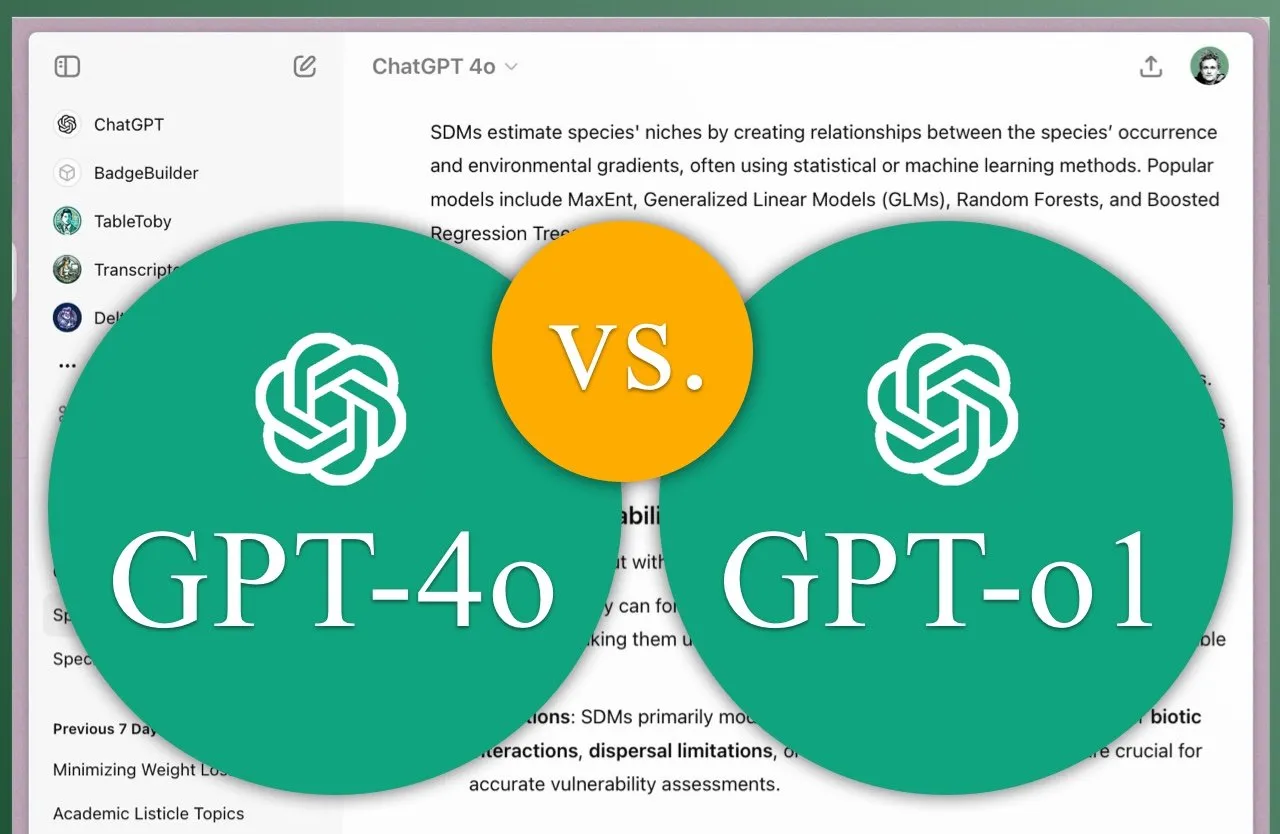OpenAI o1 is one of the newest models in the AI world, created to take natural language understanding and conversation to the next level. It’s designed to handle more complex and focused tasks, making interactions feel smoother and more intelligent. With the new o1, OpenAI aims to make AI even smarter, faster, and more intuitive for everyday and specialized use.
Comparison between OpenAI o1 and GPT-4o:
1. Versatility vs. Specialization: GPT-4o is great for a
wide range of tasks, while OpenAI o1 is more focused, delivering sharper
performance in specific areas where precision matters most.
2. Speed: OpenAI o1 responds faster than GPT-4o, making it the go-to option when you need quick answers without sacrificing quality.
3. Creativity and Logic: While GPT-4o is strong in creative tasks, OpenAI o1 takes reasoning to the next level, offering deeper insights and more structured responses, especially in technical discussions.
1. OpenAI o1 in Reasoning: Unlocking New Problem-Solving Power.
Beyond just specific fields, OpenAI o1’s strength in reasoning makes it a powerful tool for anything that needs critical thinking and logical problem-solving. Whether it’s cracking puzzles, analyzing complex arguments, or helping with tough decisions, o1 brings a new level of intelligence to tasks that require sharp reasoning and thoughtful deduction. It has the potential to unlock smarter ways to tackle challenges
2. Coding in OpenAI o1: The New!
From suggesting code optimizations and generating test cases to automating code reviews and facilitating knowledge sharing, o1 has the potential to significantly enhance developer productivity and simplify workflows.
Additionally, o1’s ability to understand and generate code extends its utility beyond just coding. It can aid in project planning, requirement analysis, and software architecture design, helping developers craft more effective solutions.
Although o1’s full capabilities are still being developed, its current features are already promising. As OpenAI continues to refine the model, o1 is likely to become a valuable tool for developers, fostering innovation and influencing the future of software development.
As described in the benchmarks section, the o1 model shows great potential in the coding field.
3. OpenAI o1 Use Cases
OpenAI o1’s reasoning capabilities make it particularly well-suited for solving complex problems in science, coding, and mathematics.
Scientific Research
Healthcare researchers, for instance, could leverage o1 to annotate intricate cell sequencing data, while physicists might employ it to generate the sophisticated mathematical formulas required for quantum optics research.
4. OpenAI o1’s demo in Mathematics:
The field of mathematics could also see significant benefits from o1’s advanced reasoning capabilities. Its strong performance on benchmarks like AIME suggests potential applications in solving complex equations, proving theorems, and exploring new mathematical concepts, benefiting both students and researchers alike.
5. How to Access OpenAI o1:
If you have a ChatGPT Plus or ChatGPT Team subscription, you can access the o1-preview model directly within the ChatGPT interface. Select o1-preview from the model selector dropdown menu at the top of the page.

Keep in mind that there are initial usage limits during the preview phase, with access restricted to 30 messages per week.
Additionally, at present, o1-preview in ChatGPT doesn’t support features like browsing, file and image uploading.
What Is OpenAI o1-mini?
Alongside the full-fledged o1-preview model, OpenAI has also released o1-mini, a smaller and faster variant designed to provide a more accessible entry point for developers and researchers exploring the capabilities of the o1 series.

While o1-mini may not possess the same depth of general knowledge as its larger counterpart, it excels in tasks that demand focused reasoning skills, particularly in the realms of coding, math, and science.
Its reduced size translates to faster response times and lower computational requirements, making it a practical choice for applications where speed and efficiency are important.
Although o1-mini is currently in beta and has certain limitations, it offers a glimpse into the potential of the o1 series and its focus on enhancing AI reasoning capabilities. As OpenAI continues to refine and develop the o1 models, we can expect o1-mini to evolve alongside its larger sibling, providing an increasingly powerful and versatile tool for a wide range of applications.
Limitations of OpenAI o1
While OpenAI o1-preview offers impressive capabilities, there are a few limitations to be aware of. These constraints might affect its usefulness in certain contexts, so it’s worth being aware of the following things
Hidden chain of thought
To ensure the potential for future monitoring and safety enhancements, the raw chain-of-thought reasoning process used by o1 is not directly visible to users. While this decision aims to enable more effective model oversight, it does limit transparency and could impact user understanding of the model’s decision-making process.
Doesn’t yet browse the web
OpenAI o1-preview cannot browse the web, which means that the information it provides may not always be up-to-date. If you’re looking for real-time or current event data, the model will not be able to retrieve it directly.
No support for files and images
At present, OpenAI o1-preview does not support file or image uploads. This limits its ability to work with multimedia data or analyze specific documents directly uploaded by users.
Longer response times
One of the most noticeable limitations is that the model takes a relatively long time to process complex queries. While this extra time allows it to produce more thoughtful responses, it may cause delays for users expecting faster answers.
Conclusion:
While we eagerly anticipated the arrival of GPT-5, OpenAI surprised us with the introduction of o1, a model that prioritizes complex reasoning capabilities.
The early successes of o1-preview across a variety of benchmarks demonstrate its potential to tackle challenging problems in fields like mathematics, coding, and scientific research.
Despite its promising capabilities, o1 is still in its early stages and faces challenges, including its compute-intensive nature and the need for ongoing research into safety and ethical deployment.
For the latest trending news on OpenAI, be sure to visit OpenAI’s Official Website.
You can also check out FOX’s coverage on Strawberry AI here.
Want to stay updated with more news like this? Visit our website, The USA International, for the latest in celebrity news, tech updates, and more! Don’t miss our exciting comparison article on the iPhone 16 Plus vs. iPhone 15 Plus—read it here!
FAQ Section:
OpenAI o1 is a new AI model focused on complex reasoning tasks like math, coding, and puzzles. It uses chain-of-thought reasoning to break down problems, improving accuracy compared to older models like GPT-4.
OpenAI o1 excels at math problems, coding challenges, data analysis, and science tasks that require multi-step reasoning.
You can access OpenAI o1 through ChatGPT, and developers can access it via OpenAI’s API.
o1-mini is a smaller version of o1, better suited for lighter tasks but with less power for complex reasoning.
Future updates may include faster response times, web browsing, and file handling.
The pricing for o1 models is usage-based and depends on the specific model and the number of tokens processed.
- For o1-preview, the cost is $15.00 per 1 million input tokens and $60.00 per 1 million output tokens.
- For o1-mini, the cost is $3.00 per 1 million input tokens and $12.00 per 1 million output tokens.
- It’s important to remember that the total token count includes both visible completion tokens and invisible reasoning tokens, which contribute to the overall cost.

